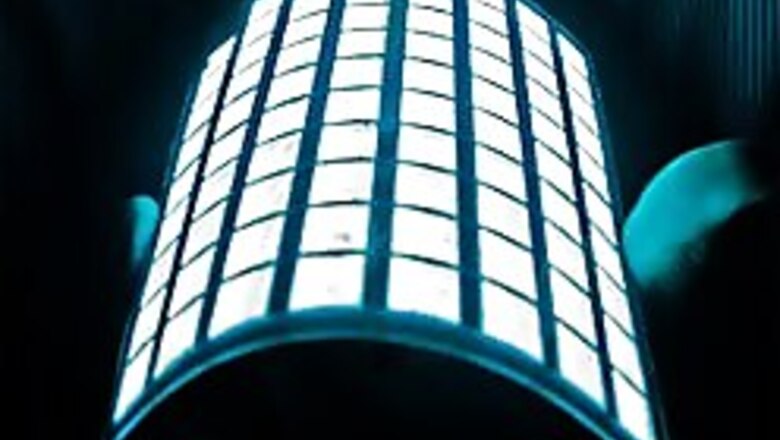
views
Niskayuna (New York): On a bank of the Mohawk River, a windowless industrial building of corrugated steel hides something that could make floor lamps, bedside lamps, wall sconces and nearly every other household lamp obsolete.
It's a machine that prints lights.
The size of a semitrailer, it coats an 8-inch wide plastic film with chemicals, then seals them with a layer of metal foil. Apply electric current to the resulting sheet, and it lights up with a blue-white glow.
You could tack that sheet to a wall, wrap it around a pillar or even take a translucent version and tape it to your windows. Unlike practically every other source of lighting, you wouldn't need a lamp or conventional fixture for these sheets, though you would need to plug them into an outlet.
The sheets owe their luminance to compounds known as organic light-emitting diodes, or OLEDs. While there are plenty of problems to be worked out with the technology, it's not the dream of a wild-eyed startup.
OLEDs are beginning to be used in TVs and cell-phone displays, and big names like Siemens and Philips are throwing their weight behind the technology to make it a lighting source as well.
The OLED printer was made by General Electric Co. on its sprawling research campus in upstate New York. It's not far from where a GE physicist figured out a practical way to use tungsten metal as the filament in a regular light bulb. That's still used today, nearly a century later.
The invention of the incandescent bulb created the pattern for home lighting: Our light sources are small and bright. Maybe there are a few in the center of the ceiling, and a few in the corners of the room. Because they're too bright to look at, they need to be reflected and diffused with lamp shades and frosted glass.
OLEDs could overturn all that, with broad, diffuse light sources bathing rooms in a gentle glow. Photographers go to great lengths to diffuse the illumination they use when shooting portraits, because they know we look our best in soft light.
The big glowing sheets could also make light sources out of everyday things. GE imagines putting OLEDs on the inside of window blinds — pull them down, light them up, and you have light streaming from the window, even at night. You could even make OLED wallpaper, since the material is flexible.
"We have a lot of ideas for what we can do with it," said German lighting designer Ingo Maurer.
He and his firm have already created the first commercially available OLED lamp, and is selling it in a limited edition of 25. He expects to deliver the first two this month, at an undisclosed but presumably collector-level price.
PAGE_BREAK
The lamp is more of a curiosity than a practical product: the light is dim, and gradually grows dimmer, losing half its brightness after 2,000 hours. Its OLED panels are only a few inches wide, and made of glass rather than plastic. They protrude from a central stem like the leaves of a fern.
The panels in Maurer's lamp are made by Osram Opto Semiconductors, a subsidiary of German industrial conglomerate Siemens AG, which is also the parent of Osram Sylvania, a competitor to GE in the general lighting market.
Osram Opto made them with an expensive, slow process known as vacuum deposition that has dominated OLED development so far. One virtue of this method is that it can be combined with the technologies that produce LCD displays to make full-color OLED TVs. Sony Corp. sells an 11-inch model for $2,500.
OLED TVs have to become much cheaper (and larger) to become mass-market products, and OLED lights have to be cheaper still. That's the issue GE is tackling with its printer, which dispenses with vacuum deposition in favor of a process that's not much more complicated than the printing of a newspaper.
"We're trying to be as low-tech as possible," said Anil Duggal, head of GE's OLED research team.
In the next step, GE plans to build a larger machine that can print panels several feet wide. Its output could be sold commercially as early as 2010, Duggal said, but he acknowledged that's a "very aggressive" goal.
Since the production runs will be small by then, the prices won't be accessible to the average consumer. But the luminous OLEDs could show up in niche, luxury settings, like casinos or fancy restaurants, where the thin and flexible lights could allow the creation of striking architectural or artistic effects.
Looking ahead a few more years, printing could reduce the cost of OLEDs to little more than the cost of the stuff it's printed on, said Janice Mahon, vice president of technology commercialization at Universal Display Corp. in Ewing, New Jersey. The company is a leader in OLED research, and develops some of the organic compounds, which are akin to the dyes used to color clothes. If printed on metal foil, the cost of an OLED light could be less than a dollar per square foot, Mahon said.
This sets OLEDs apart from another promising technology that has been hailed as the future of lighting. Inorganic LEDs, the pinhead-sized lights that adorn electronic gadgets, are beginning to show up in commercial lighting, where their extreme longevity compared to bulbs makes up for their high production cost. Since they're made with semiconductor manufacturing techniques, a cluster of LEDs that produces as much light as a standard bulb costs more than $100.
LEDs and OLEDs both hold the potential for big energy savings over standard incandescent bulbs. Matching fluorescents is tougher. Universal Display this year created OLEDs that exceeded the energy efficiency of fluorescents, but combining that feature with longevity and mass production will be a challenge.
"It's not going to be competitive with fluorescents in 2010," Duggal said.
As point light sources, LEDs are likely to coexist with the big, diffuse OLEDs, said analyst Lawrence Gasman at Nanomarkets LLC, a research firm in Glen Allen, Virginia. "Together, they make for a nice lighting future," Gasman said.
He projects that OLED lighting sales could reach $5.9 billion by 2015.
Bob Sagebiel, technical marketing manager for lighting at distributor Arrow Electronics Inc., is less optimistic. Because OLEDs are so different from current lighting technology, they could have a hard time being accepted by the market, he believes. An OLED panel won't fit in any of the 20 billion light-bulb sockets worldwide, he noted. Commercial buildings will probably need rewiring to take advantage of big panels that don't fit into existing fixtures for fluorescent tubes.
Also, for GE and Osram to reach customers with their panels, they'll need to go through makers of light fixtures, and "that's an industry that is tremendously conservative," Sagebiel said.
On the manufacturing side, there are still challenges to overcome for the technology, particularly in making OLEDs long-lasting in addition to being power-efficient. They're gradually worn out by use. Exposure to atmospheric oxygen, which can seep through plastic, destroys them quickly.
But OLED technology is, at least, in much better shape to take on the lighting market than an older technology that also produces thin and printable light sources. Electroluminescent lights, which glow in Indiglo watches and car dashboards, have been made for decades. Despite early hopes, they've never become competitive when it comes to brightness or energy efficiency.
"In the 1950s, people were talking about electroluminescence the way we talk about OLEDs today," Duggal said. "It's humbling."


















Comments
0 comment